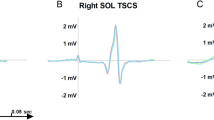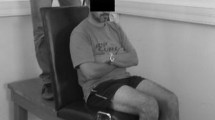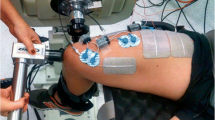Abstract
Chronic Achilles tendon vibration has previously shown its effectiveness in improving plantar flexor’s strength and activation capacities. The present study investigated the related neural mechanisms by analyzing H-reflexes and V-waves of the soleus (SOL) and gastrocnemii (GM gastrocnemius medialis; GL gastrocnemius lateralis) muscles under maximal isometric plantar flexion. Moreover, recordings were conducted bilaterally to address potential crossed effects. 11 subjects were engaged in this study. Maximal voluntary contraction and superimposed H-reflexes and V-waves were quantified in both legs at baseline (PRE) and 2 weeks later to verify repeatability of data (CON). Then, subjects were retested after 14 days of daily unilateral Achilles tendon vibration (VIB; 1 h per day; frequency: 50 Hz). No changes were reported between PRE and CON data. In the VIB condition, there was an increase in MVC for both the vibrated (+9.1 %; p = 0.016) and non-vibrated (+10.2 %; p = 0.009) legs. The H-reflex increased by a mean 25 % in the vibrated SOL (p < 0.001), while it remained unchanged for the contralateral side (p = 0.531). The SOL V-wave also increased in the vibrated limb (+43.3 %; p < 0.001), as well as in the non-vibrated one (+41.9 %; p = 0.006). Furthermore, the GM V-wave increased by 37.8 % (p = 0.081) in the vibrated side and by 39.4 % (p = 0.03) in the non-vibrated side. However, no changes were reported for the GL muscles. While the present study confirmed the strength gains induced by chronic Achilles tendon vibration, the results indicated a cross-education phenomenon with differences in neural adaptations between the vibrated leg and non-vibrated leg.



Similar content being viewed by others
References
Aagaard P, Simonsen EB, Andersen JL, Magnusson P, Dyhre-Poulsen P (2002) Neural adaptation to resistance training: changes in evoked V-wave and H-reflex responses. J Appl Physiol 92(6):2309–2318
Cannon RJ, Cafarelli E (1987) Neuromuscular adaptations to training. J Appl Physiol 63(6):2396–2402
Carroll TJ, Herbert RD, Munn J, Lee M, Gandevia SC (2006) Contralateral effects of unilateral strength training: evidence and possible mechanisms. J Appl Physiol 101(5):1514–1522
Carroll TJ, Selvanayagam VS, Riek S, Semmler JG (2011) Neural adaptations to strength training: moving beyond transcranial magnetic stimulation and reflex studies. Acta Physiol (Oxf) 202(2):119–140
Delecluse C, Roelants M, Verschueren S (2003) Strength increase after whole-body vibration compared with resistance training. Med Sci Sports Exerc 35(6):1033–1041
Duchateau J (1995) Bed rest induces neural and contractile adaptations in triceps surae. Med Sci Sports Exerc 27(12):1581–1589
Duclay J, Martin A (2005) Evoked H-reflex and V-wave responses during maximal isometric, concentric, and eccentric muscle contraction. J Neurophysiol 94(5):3555–3562
Duclay J, Martin A, Robbe A, Pousson M (2008) Spinal reflex plasticity during maximal dynamic contractions after eccentric training. Med Sci Sports Exerc 40(4):722–734
Ekblom MM (2010) Improvements in dynamic plantar flexor strength after resistance training are associated with increased voluntary activation and V-to-M ratio. J Appl Physiol 109(1):19–26
Eklund G, Hagbarth KE (1966) Normal variability of tonic vibration reflexes in man. Exp Neurol 16(1):80–92
Falempin M, In-Albon SF (1999) Influence of brief daily tendon vibration on rat soleus muscle in non-weight-bearing situation. J Appl Physiol 87(1):3–9
Fimland MS, Helgerud J, Solstad GM, Iversen VM, Leivseth G, Hoff J (2009) Neural adaptations underlying cross-education after unilateral strength training. Eur J Appl Physiol 107(6):723–730
Forner-Cordero A, Steyvers M, Levin O, Alaerts K, Swinnen SP (2008) Changes in corticomotor excitability following prolonged muscle tendon vibration. Behav Brain Res 190(1):41–49
Gondin J, Guette M, Maffiuletti NA, Martin A (2004) Neural activation of the triceps surae is impaired following 2 weeks of immobilization. Eur J Appl Physiol 93(3):359–365
Gondin J, Duclay J, Martin A (2006) Soleus- and gastrocnemii-evoked V-wave responses increase after neuromuscular electrical stimulation training. J Neurophysiol 95(6):3328–3335
Gottlieb GL, Agarwal GC (1971) Effects of initial conditions on the Hoffman reflex. J Neurol Neurosurg Psychiatry 34(3):226–230
Hortobagyi T, Scott K, Lambert J, Hamilton G, Tracy J (1999) Cross-education of muscle strength is greater with stimulated than voluntary contractions. Mot Control 3(2):205–219
Hugon M (1973) Methodology of the Hoffmann reflex in man. In: Desmedt JE (ed) Progress in clinical neurophysiology, new developments in electromyography and clinical neurophysiology, vol 3. Karger, Switzerland, pp 227–293
Issurin VB, Liebermann DG, Tenenbaum G (1994) Effect of vibratory stimulation training on maximal force and flexibility. J Sports Sci 12(6):561–566
Jackson SW, Turner DL (2003) Prolonged muscle vibration reduces maximal voluntary knee extension performance in both the ipsilateral and the contralateral limb in man. Eur J Appl Physiol 88(4–5):380–386
Kossev A, Siggelkow S, Schubert M, Wohlfarth K, Dengler R (1999) Muscle vibration: different effects on transcranial magnetic and electrical stimulation. Muscle Nerve 22(7):946–948
Kossev A, Siggelkow S, Kapels H, Dengler R, Rollnik JD (2001) Crossed effects of muscle vibration on motor-evoked potentials. Clin Neurophysiol 112(3):453–456
Lagerquist O, Zehr EP, Docherty D (2006) Increased spinal reflex excitability is not associated with neural plasticity underlying the cross-education effect. J Appl Physiol 100(1):83–90
Lapole T, Pérot C (2010) Effects of repeated Achilles tendon vibration on triceps surae force production. J Electromyogr Kinesiol 20(4):648–654
Lapole T, Pérot C (2011) Effects of repeated Achilles tendon vibration on triceps surae stiffness and reflex excitability. J Electromyogr Kinesiol 21(1):87–94
Lapole T, Pérot C (2012) Hoffmann reflex is increased after 14 days of daily repeated Achilles tendon vibration for the soleus but not for the gastrocnemii muscles. Appl Physiol Nutr Metab 37(1):14–20
Lapole T, Canon F, Pérot C (2012a) Acute postural modulation of the soleus H-reflex after Achilles tendon vibration. Neurosci Lett 523(2):154–157
Lapole T, Deroussen F, Pérot C, Petitjean M (2012b) Acute effects of Achilles tendon vibration on soleus and tibialis anterior spinal and cortical excitability. Appl Physiol Nutr Metab 37(4):657–663
Lundbye-Jensen J, Nielsen JB (2008) Central nervous adaptations following 1 wk of wrist and hand immobilization. J Appl Physiol 105(1):139–151
Luo J, McNamara B, Moran K (2005) The use of vibration training to enhance muscle strength and power. Sports Med 35(1):23–41
Mezzarane RA, Kohn AF, Couto-Roldan E, Martinez L, Flores A, Manjarrez E (2012) Absence of effects of contralateral group I muscle afferents on presynaptic inhibition of Ia terminals in humans and cats. J Neurophysiol 108(4):1176–1185
Misiaszek JE (2003) The H-reflex as a tool in neurophysiology: its limitations and uses in understanding nervous system function. Muscle Nerve 28(2):144–160
Moritani T, deVries HA (1979) Neural factors versus hypertrophy in the time course of muscle strength gain. Am J Phys Med 58(3):115–130
Munte TF, Jobges EM, Wieringa BM, Klein S, Schubert M, Johannes S, Dengler R (1996) Human evoked potentials to long duration vibratory stimuli: role of muscle afferents. Neurosci Lett 216(3):163–166
Pensini M, Martin A (2004) Effect of voluntary contraction intensity on the H-reflex and V-wave responses. Neurosci Lett 367(3):369–374
Ridding MC, McKay DR, Thompson PD, Miles TS (2001) Changes in corticomotor representations induced by prolonged peripheral nerve stimulation in humans. Clin Neurophysiol 112(8):1461–1469
Rittweger J (2010) Vibration as an exercise modality: how it may work, and what its potential might be. Eur J Appl Physiol 108(5):877–904
Roelants M, Delecluse C, Verschueren SM (2004) Whole-body-vibration training increases knee-extension strength and speed of movement in older women. J Am Geriatr Soc 52(6):901–908
Sale DG (1988) Neural adaptation to resistance training. Med Sci Sports Exerc 20(5 Suppl):S135–S145
Schieppati M (1987) The Hoffmann reflex: a means of assessing spinal reflex excitability and its descending control in man. Prog Neurobiol 28(4):345–376
Solstad GM, Fimland MS, Helgerud J, Iversen VM, Hoff J (2011) Test–retest reliability of v-wave responses in the soleus and gastrocnemius medialis. J Clin Neurophys Off Publ Am Electroencephalogr Soc 28(2):217–221
Steyvers M, Levin O, Verschueren SM, Swinnen SP (2003) Frequency-dependent effects of muscle tendon vibration on corticospinal excitability: a TMS study. Exp Brain Res 151(1):9–14
Swayne O, Rothwell J, Rosenkranz K (2006) Transcallosal sensorimotor integration: effects of sensory input on cortical projections to the contralateral hand. Clin Neurophysiol 117(4):855–863
Tognella F, Mainar A, Vanhoutte C, Goubel F (1997) A mechanical device for studying mechanical properties of human muscles in vivo. J Biomech 30(10):1077–1080
Tokimura H, Di Lazzaro V, Tokimura Y, Oliviero A, Profice P, Insola A, Mazzone P, Tonali P, Rothwell JC (2000) Short latency inhibition of human hand motor cortex by somatosensory input from the hand. J Physiol 523(Pt 2):503–513
Upton AR, McComas AJ, Sica RE (1971) Potentiation of “late” responses evoked in muscles during effort. J Neurol Neurosurg Psychiatry 34(6):699–711
Verschueren SM, Roelants M, Delecluse C, Swinnen S, Vanderschueren D, Boonen S (2004) Effect of 6-month whole body vibration training on hip density, muscle strength, and postural control in postmenopausal women: a randomized controlled pilot study. J Bone Miner Res 19(3):352–359
Vila-Cha C, Falla D, Correia MV, Farina D (2012) Changes in H reflex and V wave following short-term endurance and strength training. J Appl Physiol 112(1):54–63
Voigt M, Chelli F, Frigo C (1998) Changes in the excitability of soleus muscle short latency stretch reflexes during human hopping after 4 weeks of hopping training. Eur J Appl Physiol Occup Physiol 78(6):522–532
Zehr PE (2002) Considerations for use of the Hoffmann reflex in exercise studies. Eur J Appl Physiol 86(6):455–468
Zhao X, Fan X, Song X, Shi L (2011) Daily muscle vibration amelioration of neural impairments of the soleus muscle during 2 weeks of immobilization. J Electromyogr Kinesiol 21(6):1017–1022
Acknowledgments
This study was supported by grants of the Centre National d’Etudes Spatiales (CNES, France).
Author information
Authors and Affiliations
Corresponding author
Additional information
Communicated by Toshio Moritani.
Rights and permissions
About this article
Cite this article
Lapole, T., Canon, F. & Pérot, C. Ipsi- and contralateral H-reflexes and V-waves after unilateral chronic Achilles tendon vibration. Eur J Appl Physiol 113, 2223–2231 (2013). https://doi.org/10.1007/s00421-013-2651-6
Received:
Accepted:
Published:
Issue Date:
DOI: https://doi.org/10.1007/s00421-013-2651-6




